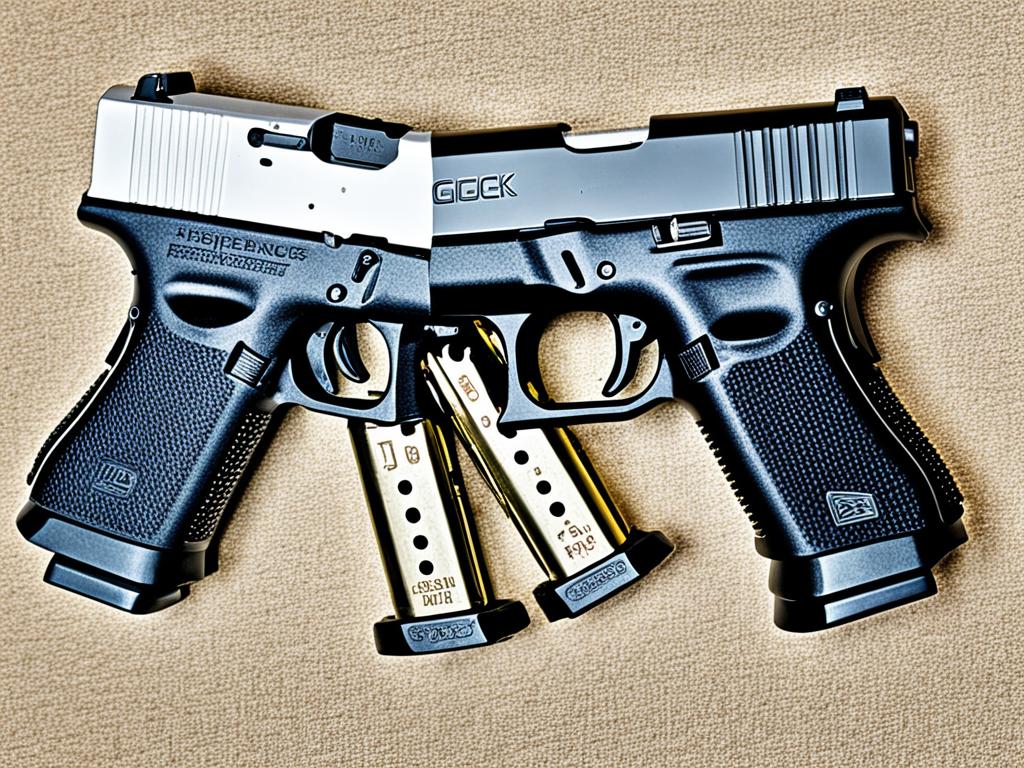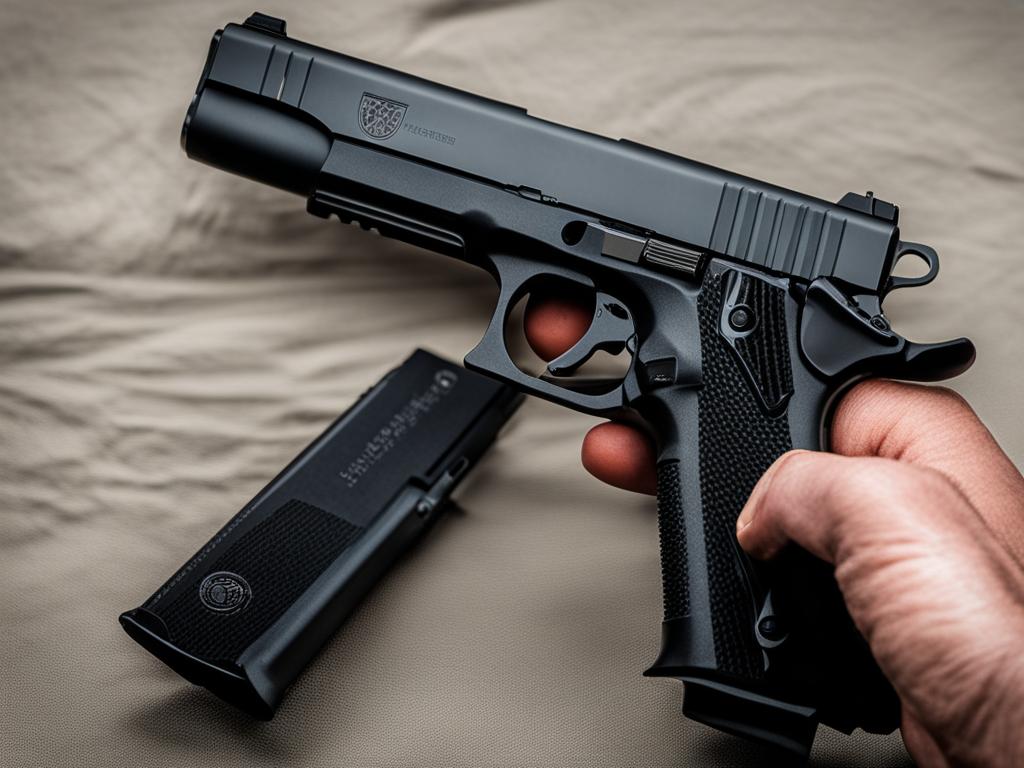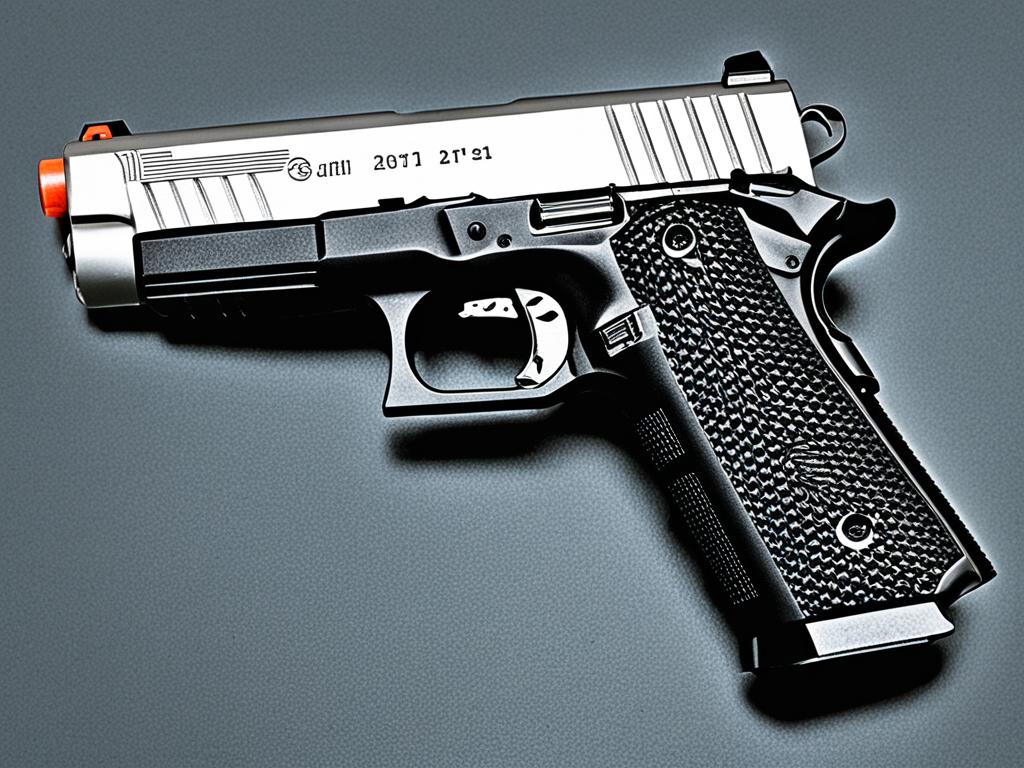Did you know that the Glock 21 and the 1911 are two of the most popular handguns in the world? These iconic pistols have been trusted by military and law enforcement agencies for decades, and now, many gun enthusiasts are faced with the decision of which one to choose for their self-defense needs. In this article, we will explore the key differences between the Glock 21 and the 1911, helping you make an informed decision.
Key Takeaways:
- The Glock 21 and the 1911 are both highly regarded handguns for self-defense.
- The Glock 21 features a lightweight polymer frame, while the 1911 is made of steel.
- Both pistols offer reliable performance and accuracy.
- Consider factors such as caliber, trigger pull, and weight when deciding between the Glock 21 and the 1911.
- Ultimately, the choice between the two pistols depends on personal preference and specific needs.
History and Profile of the Glock 21 and 1911
When it comes to the iconic pistols of the firearms industry, the Glock 21 and the 1911 stand out as timeless choices. In this section, we will delve into the rich history and profile of these two handguns, shedding light on their origins and development.
The 1911: A Design by John Moses Browning
The 1911 pistol was designed by the legendary firearms inventor John Moses Browning. It was created in response to the US military’s need for a more effective sidearm during the early 20th century. Browning’s innovative design quickly gained popularity and became the standard-issue handgun for the US military.
Image:
The Glock 21: A Revolution in Polymer Construction
In contrast, the Glock 21 was developed by Gaston Glock, a visionary entrepreneur and founder of the Glock company. Prior to designing firearms, Glock was involved in manufacturing curtain rods. However, he utilized his knowledge of advanced synthetic polymers to create the Glock 17, which laid the foundation for the Glock 21.
The Glock 21 introduced a groundbreaking approach to handgun construction, incorporating a lightweight and durable polymer frame. The use of synthetic materials not only reduced the weight of the pistol but also provided resistance to rust and corrosion. This innovation propelled the Glock 21 into the spotlight, making it a favorite among military and law enforcement agencies worldwide.
| Attribute | Glock 21 | 1911 |
|---|---|---|
| Designer | Gaston Glock | John Moses Browning |
| Frame | Polymer | Steel |
| Weight | Varies (depending on model) | Varies (depending on manufacturer and model) |
| Popularity | Increasing | Classic |
Both the Glock 21 and the 1911 have made significant contributions to the firearms industry and have proven themselves as reliable options for self-defense and professional use. While the 1911 remains a beloved classic, the Glock 21’s innovative design and practical features have earned it a dedicated following.
Construction and Durability: Steel vs Polymer
When comparing the Glock 21 and the 1911, one of the fundamental distinctions lies in their construction. The 1911 boasts a steel frame, which gives it a solid and weighty feel, while the Glock 21 features a polymer frame that is lightweight and rust-proof. Both pistols are renowned for their durability, each with its own unique advantages.
The 1911’s steel frame provides it with a robust foundation, making it highly resistant to wear and tear. This construction choice ensures longevity and a sturdy, reliable firearm that can withstand heavy use over time. Additionally, the steel frame imparts a sense of stability and balance when handling the pistol, promoting accurate shooting.
On the other hand, the Glock 21’s polymer frame offers distinct benefits. The lightweight nature of the polymer makes it easier to carry for extended periods, reducing fatigue and enhancing maneuverability. The polymer frame is also impact-resistant, meaning it can absorb shock without compromising the pistol’s functionality. This attribute is especially valuable in high-stress situations or during rigorous training exercises.
Furthermore, the Glock 21’s polymer frame is notably less affected by temperature changes compared to the 1911’s steel frame. The polymer material is inherently less prone to expansion and contraction due to temperature fluctuations, ensuring consistent performance in various climates.
| Glock 21 | 1911 |
|---|---|
| Durable polymer frame | Sturdy steel frame |
| Lightweight and rust-proof | Heavy feel with a solid build |
| Impact-resistant and reliable | Long-lasting and wear-resistant |
| Less affected by temperature changes | Stability and balance in handling |
It’s important to note that both construction types have proven their durability in real-life scenarios and have been trusted by professionals in military, law enforcement, and self-defense contexts. The choice between the Glock 21 and the 1911 ultimately depends on individual preferences regarding weight, handling, and shooting experience.
Stay tuned for the next section where we will delve into the caliber and knockdown power of these two pistols.
Caliber and Knock Down Power
When comparing the Glock 21 and the 1911, one of the crucial factors to consider is the caliber and knock down power they offer.
The 1911 is chambered for .45 ACP, which is well-known for its perceived knock down power. However, it’s important to note that the belief that .45 ACP has more stopping power than 9mm Luger is not entirely accurate. While caliber does play a role in stopping power, other factors such as the velocity and kinetic energy of the projectile are equally important.
The 9mm Luger often has higher velocity, which can result in more kinetic energy compared to .45 ACP. This means that the 9mm can deliver similar or even greater stopping power in certain scenarios. Both the Glock 21 and the 1911 offer options for chambering .45 ACP, giving users the flexibility to choose the caliber that best suits their preferences and needs.
It’s worth considering that factors such as shot placement, ammunition type, and individual shooting proficiency also have a significant impact on the effectiveness of a handgun. It’s always advisable to practice and seek proper training to maximize the capabilities of any firearm.

This table provides a comparison of the Glock 21 and the 1911 in terms of caliber:
| Glock 21 | 1911 |
|---|---|
| Chambered for .45 ACP | Chambered for .45 ACP |
| Options for other calibers available | N/A |
As seen in the table, both pistols offer the option for .45 ACP, providing users with a common caliber choice. However, it’s important to keep in mind that the stopping power of a handgun relies on various factors, and caliber alone does not determine its effectiveness.
Accuracy and Trigger Pull
When it comes to accuracy, both the Glock 21 and the 1911 are known for their reliable performance, especially at close-quarters distances. However, there are notable differences in their trigger pulls that can impact shooting precision and overall user experience.
The 1911 is widely praised for its crisp and precise trigger feel. The single-action trigger design provides a short take-up and a light, clean break, allowing shooters to achieve exceptional accuracy with each shot. This feature has made the 1911 a favorite among competitive shooters and enthusiasts who prioritize precise trigger control.
On the other hand, the Glock 21’s trigger is designed with a different focus – safety and reliability. The Glock Safe Action trigger offers a consistent pull with a slightly longer take-up and a relatively heavier trigger weight. This design ensures that the pistol will only fire when intentionally engaged, reducing the risk of accidental discharges. While the Glock’s trigger may lack the crispness of the 1911, it still provides sufficient accuracy for self-defense purposes.
For Glock owners who prefer a crisper trigger pull, there is an option to upgrade the trigger. Aftermarket accessories, such as enhanced trigger connectors or complete trigger kits, can improve the Glock 21’s trigger feel, providing a lighter pull and a cleaner break.
Ultimately, the choice between the Glock 21 and the 1911 in terms of trigger pull comes down to personal preference. Shooters who prioritize a precise and refined trigger experience may lean towards the 1911, while those who value safety and reliability may opt for the Glock 21. Regardless of the choice, both pistols offer adequate accuracy for their intended purposes.

| Glock 21 | 1911 | |
|---|---|---|
| Trigger Pull | Longer take-up, heavier weight | Short take-up, light break |
| Accuracy | Accurate enough for self-defense | Exceptionally accurate |
| Aftermarket Options | Upgradeable for crisper trigger pull | N/A |
Bear Defense Considerations and Conclusion
When it comes to choosing a pistol for bear defense, there are a few key factors you should consider. One of the most important considerations is weight. The lighter the pistol, the easier it will be to carry and maneuver in the event of a bear encounter. In this regard, the Glock 21 has an advantage over the 1911, as it is typically lighter in weight.
Another factor to take into account is magazine capacity. When facing a bear, having a higher magazine capacity can be advantageous. The Glock 21 offers a larger magazine capacity compared to the 1911, allowing for more rounds to be fired without the need for reloading.
Of course, personal preference and comfort with the firearm should also be taken into consideration. It’s important to choose a pistol that you feel confident and comfortable using in a high-stress situation. The Glock 21 and the 1911 both have their loyal fan bases, so it ultimately comes down to individual preferences and needs.
In conclusion, the Glock 21 with its lighter weight and higher magazine capacity can be a suitable choice for bear defense. However, it’s essential to choose a firearm that you are proficient with and feel comfortable using. Ultimately, the decision between the Glock 21 and the 1911 for bear defense should be based on individual needs, preferences, and shooting proficiency.
FAQ
What are the key differences between the Glock 21 and the 1911?
The key differences between the Glock 21 and the 1911 include their construction, caliber options, and trigger pull.
Is the Glock 21 more reliable than the 1911?
Both the Glock 21 and the 1911 are known for their reliability, but the Glock’s polymer frame offers added durability and resistance to rust and corrosion.
Which pistol is more accurate, the Glock 21 or the 1911?
Both the Glock 21 and the 1911 are accurate pistols, particularly at close-quarters distances. However, the 1911 is often praised for its crisp and precise trigger pull.
What is the knock down power of the Glock 21 and the 1911?
Both the Glock 21 and the 1911 chamber .45 ACP, which is known for its perceived knock down power. However, the 9mm Luger may have more kinetic energy due to its higher velocity.
Is the Glock 21 or the 1911 better for self-defense?
Both the Glock 21 and the 1911 are reliable choices for self-defense. The decision ultimately depends on personal preferences and comfort with the firearm.
Which pistol is lighter and has a higher magazine capacity, the Glock 21 or the 1911?
The Glock 21 is typically lighter and offers a higher magazine capacity compared to the 1911, making it advantageous for bear defense.

Leave a Reply